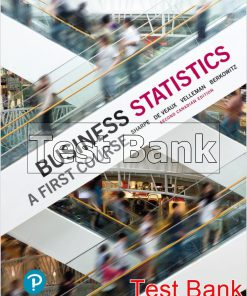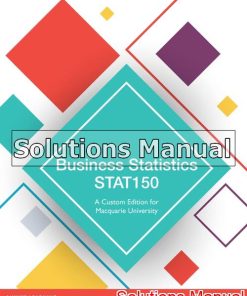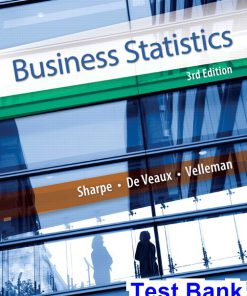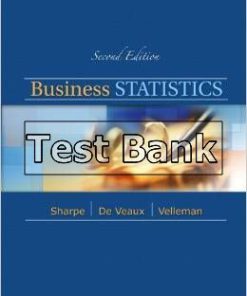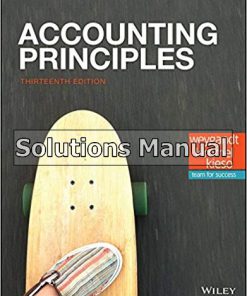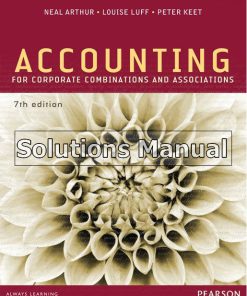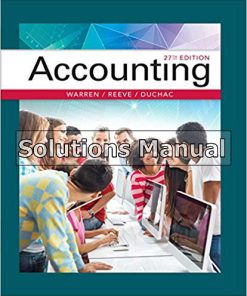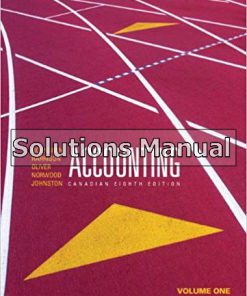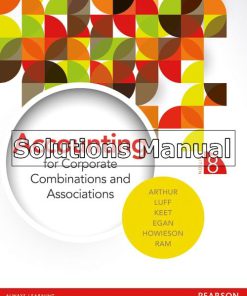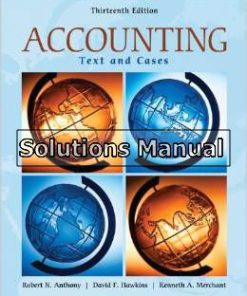Business Statistics Canadian 3rd Edition Sharpe Solutions Manual
$26.50$50.00 (-47%)
Business Statistics Canadian 3rd Edition Sharpe Solutions Manual.
You may also like
-
$26.50
$50.00 -
$26.50
$50.00
Business Statistics Canadian 3rd Edition Sharpe Solutions Manual
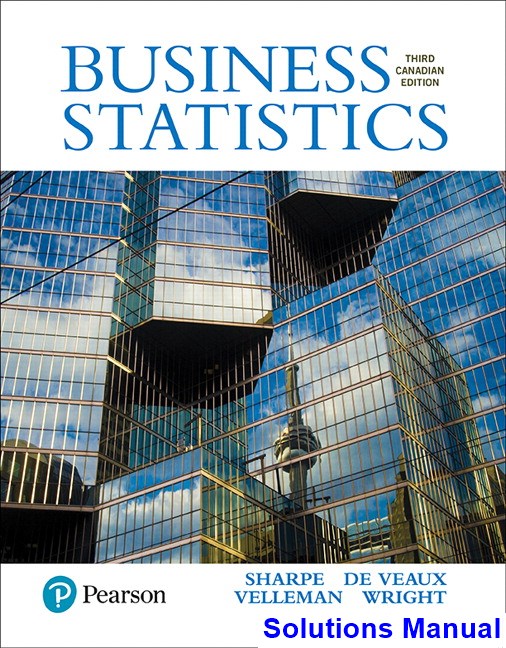
Product details:
- ISBN-10 : 0133899128
- ISBN-13 : 978-0133899122
- Author: Norean Radke Sharpe
Conceptual and applied, with emphasis on analyzing and interpreting Canadian data to make informed business decisions. The book draws students in using a conversational writing style and delivers content with a fresh, exciting approach that reflects the authors’ blend of teaching, consulting, and entrepreneurial experiences.
Table contents:
- CHAPTER 1: Introduction to Statistics and Business Analytics
- Introduction
- 1.1 Basic Statistical Concepts
- 1.2 Variables, Data, and Data Measurement
- 1.3 Big Data
- 1.4 Business Analytics
- 1.5 Data Mining and Data Visualization
- End-of-Chapter Review
- CHAPTER 2: Visualizing Data with Charts and Graphs
- Introduction
- 2.1 Frequency Distributions
- 2.2 Quantitative Data Graphs
- 2.3 Qualitative Data Graphs
- 2.4 Charts and Graphs for Two Variables
- 2.5 Visualizing Time-Series Data
- End-of-Chapter Review
- CHAPTER 3: Descriptive Statistics
- Introduction
- 3.1 Measures of Central Tendency
- 3.2 Measures of Variability
- 3.3 Measures of Shape
- 3.4 Business Analytics Using Descriptive Statistics
- End-of-Chapter Review
- CHAPTER 4: Probability
- Introduction
- 4.1 Introduction to Probability
- 4.2 Structure of Probability
- 4.3 Marginal, Union, Joint, and Conditional Probabilities
- 4.4 Addition Laws
- 4.5 Multiplication Laws
- 4.6 Conditional Probability
- 4.7 Revision of Probabilities: Bayes’ Rule
- End-of-Chapter Review
- CHAPTER 5: Discrete Distributions
- Introduction
- 5.1 Discrete Versus Continuous Distributions
- 5.2 Describing a Discrete Distribution
- 5.3 Binomial Distribution
- 5.4 Poisson Distribution
- 5.5 Hypergeometric Distribution
- End-of-Chapter Review
- CHAPTER 6: Continuous Distributions
- Introduction
- 6.1 Uniform Distribution
- 6.2 Normal Distribution
- 6.3 Using the Normal Curve to Approximate Binomial Distribution Problems
- 6.4 Exponential Distribution
- End-of-Chapter Review
- CHAPTER 7: Sampling and Sampling Distributions
- Introduction
- 7.1 Sampling
- 7.2 Sampling Distribution of x¯
- 7.3 Sampling Distribution of pˆ
- End-of-Chapter Review
- CHAPTER 8: Statistical Inference: Estimation for Single Populations
- Introduction
- 8.1 Estimating the Population Mean Using the z Statistic (σ Known)
- 8.2 Estimating the Population Mean Using the t Statistic (σ Unknown)
- 8.3 Estimating the Population Proportion
- 8.4 Estimating the Population Variance
- 8.5 Estimating Sample Size
- End-of-Chapter Review
- CHAPTER 9: Statistical Inference: Hypothesis Testing for Single Populations
- Introduction
- 9.1 Introduction to Hypothesis Testing
- 9.2 Testing Hypotheses About a Population Mean Using the z Statistic (σ Known)
- 9.3 Testing Hypotheses About a Population Mean Using the t Statistic (σ Unknown)
- 9.4 Testing Hypotheses About a Proportion
- 9.5 Testing Hypotheses About a Variance
- 9.6 Solving for Type II Errors
- End-of-Chapter Review
- CHAPTER 10: Statistical Inferences About Two Populations
- Introduction
- 10.1 Hypothesis Testing and Confidence Intervals About the Difference in Two Means Using the z Statistic: Population Variances Known
- 10.2 Hypothesis Testing and Confidence Intervals About the Difference in Two Means Using the t Statistic: Independent Samples with Population Variances Unknown
- 10.3 Statistical Inferences for Two Related Populations
- 10.4 Statistical Inferences About TwoPopulation Proportions, p1 − p2
- 10.5 Testing Hypotheses About Two Population Variances
- End-of-Chapter Review
- CHAPTER 11: Analysis of Variance and Design of Experiments
- Introduction
- 11.1 Introduction to Design of Experiments
- 11.2 The Completely Randomized Design (One-Way ANOVA)
- 11.3 Multiple Comparison Tests
- 11.4 The Randomized Block Design
- 11.5 A Factorial Design (Two-Way ANOVA)
- End-of-Chapter Review
- CHAPTER 12: Correlation and Simple Regression Analysis
- Introduction
- 12.1 Correlation
- 12.2 Introduction to Simple Regression Analysis
- 12.3 Determining the Equation of the Regression Line
- 12.4 Residual Analysis
- 12.5 Standard Error of the Estimate
- 12.6 Coefficient of Determination
- 12.7 Hypothesis Tests for the Slope of the Regression Model and for the Overall Model
- 12.8 Estimation
- 12.9 Using Regression to Develop a Forecasting Trend Line
- End-of-Chapter Review
- CHAPTER 13: Multiple Regression Analysis
- Introduction
- 13.1 The Multiple Regression Model
- 13.2 Significance Tests of the Regression Model and Its Coefficients
- 13.3 Residuals, Standard Error of the Estimate, and R2
- 13.4 Interpreting Multiple Regression Computer Output
- 13.5 Using Regression Analysis: Some Caveats
- End-of-Chapter Review
- CHAPTER 14: Building Multiple Regression Models
- 14.1 Nonlinear Models: Mathematical Transformation
- 14.2 Indicator (Dummy) Variables
- 14.3 Model Building: Search procedures
- 14.4 Multicollinearity
- 14.5 Logistic Regression
- End-of-Chapter Review
- CHAPTER 15: Time-Series Forecasting and Index Numbers
- Introduction
- 15.1 Introduction to Forecasting
- 15.2 Smoothing Techniques
- 15.3 Trend Analysis
- 15.4 Seasonal Effects
- 15.5 Autocorrelation and Autoregression
- 15.6 Index Numbers
- End-of-Chapter Review
- CHAPTER 16: Analysis of Categorical Data
- Introduction
- 16.1 Chi-Square Goodness-of-Fit Test
- 16.2 Contingency Analysis: Chi-Square Test of Independence
- End-of-Chapter Review
- CHAPTER 17: Nonparametric Statistics
- Introduction
- 17.1 Runs Test
- 17.2 Mann-Whitney U Test
- 17.3 Wilcoxon Matched-Pairs Signed Rank Test
- 17.4 Kruskal-Wallis Test
- 17.5 Friedman Test
- 17.6 Spearman’s Rank Correlation
- End-of-Chapter Review
- CHAPTER 18: Statistical Quality Control
- Introduction
- 18.1 Introduction to Quality Control
- 18.2 Process Analysis
- 18.3 Control Charts
- End-of-Chapter Review
- CHAPTER 19: Decision Analysis
- Introduction
- 19.1 The Decision Table and Decision-Making Under Certainty
- 19.2 Decision-Making Under Uncertainty
- 19.3 Decision-Making Under Risk
- 19.4 Revising Probabilities in Light of Sample Information
- End-of-Chapter Review
- Appendix A: Tables
- Appendix B: Making Inferences About Population Parameters: A Brief Summary
- Appendix C: Answers to Selected Odd-Numbered Quantitative Problems
- Glossary
- Index
- End User License Agreement
People also search:
business statistics 4th edition sharpe pdf
business statistics sharpe 4th edition
business statistics 3rd edition
business statistics sharpe
business statistics third canadian edition

